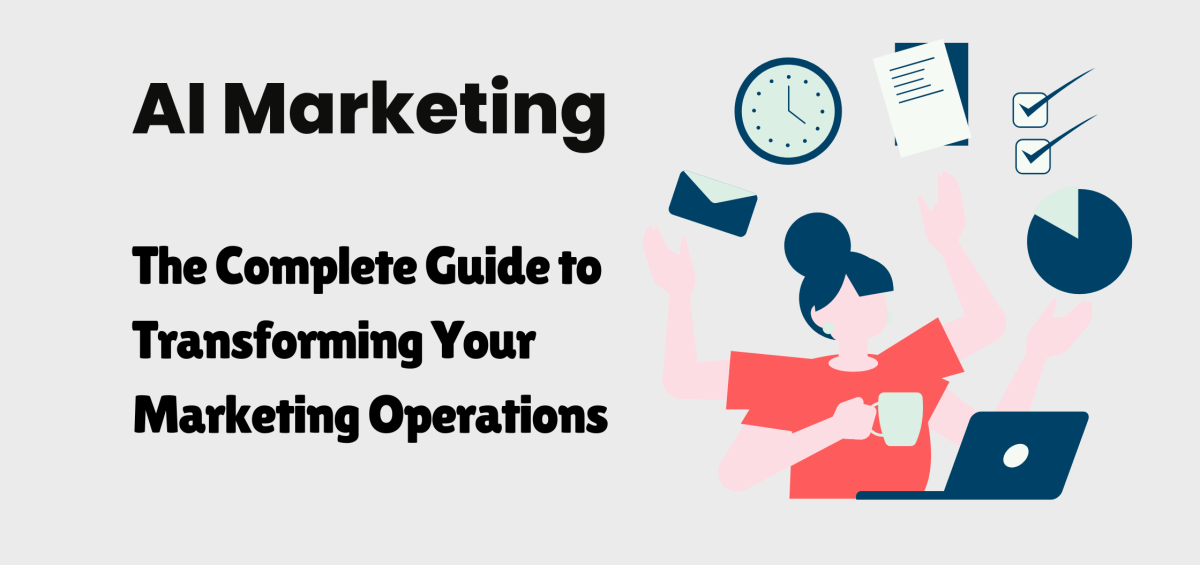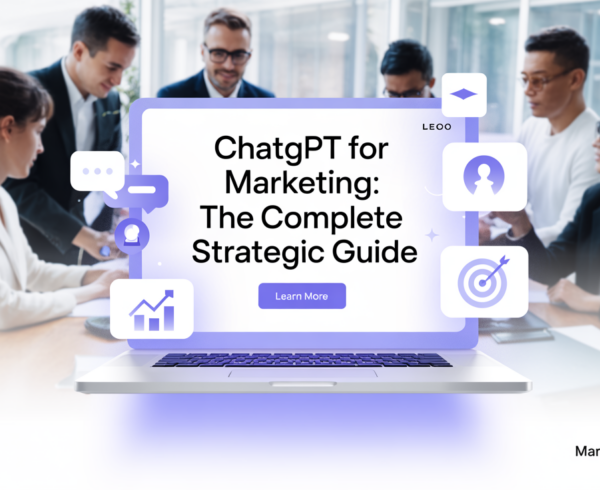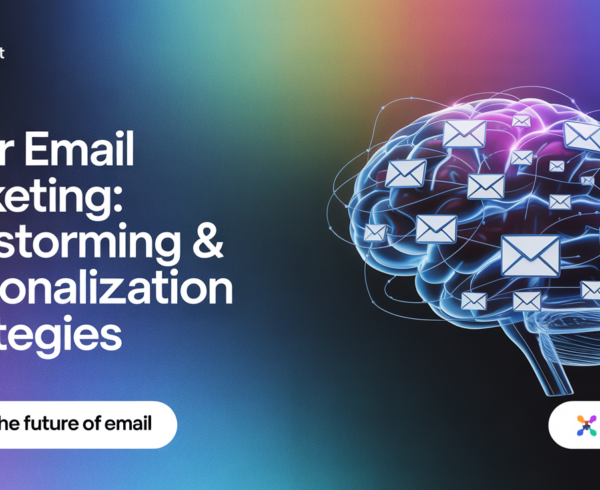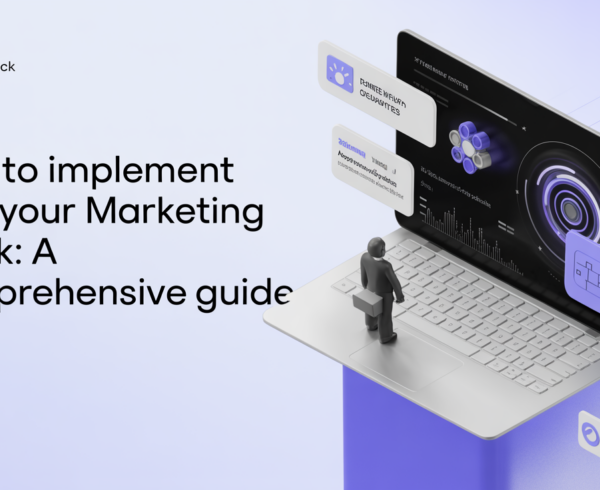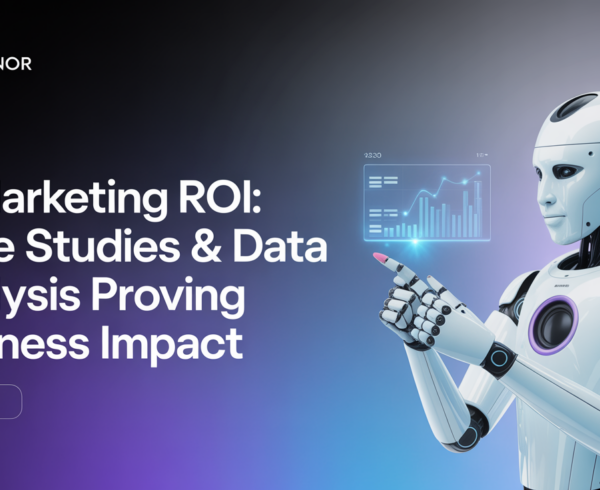The AI Marketing Revolution
Artificial intelligence is fundamentally transforming how marketing teams operate, driving unprecedented efficiency, personalisation, and performance. What was once considered futuristic is now essential for competitive advantage. According to recent industry research, 35% of businesses have already integrated AI into their marketing operations, with another 42% actively developing implementation plans. Early adopters are reporting substantial benefits, with over 92% seeing measurable results from their AI initiatives.
The impact is clear: organisations leveraging AI in marketing are experiencing 3-15% revenue increases and 10-20% improvements in marketing ROI. These gains come from AI’s ability to analyze vast amounts of data at scale, identify patterns humans might miss, automate routine tasks, and deliver hyper-personalised customer experiences.
This guide explores how AI is revolutionizing marketing across key operational areas, providing practical frameworks for implementation, and showcasing real-world examples of AI marketing success. Whether you’re just beginning your AI journey or looking to optimize existing efforts, this resource will help you navigate the transformative potential of AI marketing technologies.
1. Audience Segmentation and Targeting with AI
The Evolution from Traditional to AI-Powered Segmentation
Traditional Approach: Marketing teams manually defining segments based on broad demographic data and limited behavioral signals, often resulting in generic targeting.
AI-Powered Approach: Machine learning algorithms continuously analyzing thousands of data points to identify nuanced audience segments based on behavior patterns, preferences, and predictive indicators of future actions.
Real-World Problem Solving
Problem: A retail company struggled with broad customer segmentation that resulted in lower engagement rates and campaign ROI.
AI Solution: Implemented machine learning to analyze customer purchase history, browsing patterns, and engagement data across channels.
Outcome: Discovered 15 distinct customer micro-segments with unique purchasing triggers, allowing for highly targeted campaigns that increased conversion rates by 34% and reduced customer acquisition costs by 22%.
Practical Use Cases
- Dynamic Audience Discovery: AI identifies previously unknown audience segments based on behavioral patterns rather than predetermined categories.
- Outcome: A travel company discovered a valuable segment of “spontaneous luxury weekenders” that represented just 4% of their audience but 18% of revenue.
- Predictive Audience Value Scoring: AI predicts the potential lifetime value of customers early in their journey.
- Outcome: A subscription service prioritized high-value acquisition targets, increasing customer lifetime value by 27%.
- Cross-Channel Audience Unification: AI connects customer identities across devices and platforms.
- Outcome: A media company increased addressable audience by 45% by unifying fragmented customer profiles.
Implementation Challenges and Solutions
Challenge: Data silos prevent comprehensive customer view. Solution: Implement data lakes/warehouses to unify customer data before applying AI segmentation.
Challenge: Privacy regulations limit data collection. Solution: Focus on first-party data enrichment and develop transparent value exchanges for customer data.
2. Content Generation and Personalisation
The Evolution from Traditional to AI-Powered Content
Traditional Approach: Creating generic content for broad audience segments with manual A/B testing for optimization.
AI-Powered Approach: Generating and personalising content at scale based on individual preferences, with continuous optimization through machine learning.
Real-World Problem Solving
Problem: An e-commerce company struggled to create product descriptions for thousands of SKUs, leading to inconsistent quality and generic messaging.
AI Solution: Implemented an AI content generation system trained on their brand voice and product knowledge.
Outcome: Generated unique descriptions for over 15,000 products in three weeks (vs. an estimated 6 months manually), increased organic search traffic by 26%, and improved conversion rates by 18%.
Practical Use Cases
- Automated Email Personalisation: AI tailors subject lines, body content, and send times based on individual engagement patterns.
- Outcome: A B2B technology company increased email open rates by 35% and click-through rates by 28%.
- Dynamic Website Content: AI customizes web content based on visitor behavior and preferences.
- Outcome: A financial services firm saw a 42% increase in qualified lead submissions after implementing AI-driven content personalisation.
- Multilingual Content Adaptation: AI translates and culturally adapts marketing content for global audiences.
- Outcome: An international retailer reduced localization costs by 60% while expanding into 12 new markets.
Implementation Challenges and Solutions
Challenge: Maintaining brand voice consistency in AI-generated content.
Solution: Create detailed brand guidelines for AI training and implement human review workflows for quality assurance.
Challenge: Overcoming the “uncanny valley” of personalisation where it feels intrusive.
Solution: Develop transparency around data usage and focus on helpful rather than merely impressive personalisation.
3. Campaign Optimization and Performance Analytics
The Evolution from Traditional to AI-Powered Campaign Management
Traditional Approach: Manual campaign setup with static budgets, periodic performance reviews, and slow optimization cycles.
AI-Powered Approach: Dynamic campaign management with real-time budget allocation, continuous performance monitoring, and automated optimization.
Real-World Problem Solving
Problem: A digital marketing agency was manually adjusting bids across thousands of keywords and ad placements, unable to optimize in real-time.
AI Solution: Implemented AI-powered bid management that analyzed performance patterns and adjusted spend automatically.
Outcome: Reduced cost-per-acquisition by 32%, increased conversion volume by 24%, and freed the team to focus on strategic campaign improvements rather than tactical adjustments.
Practical Use Cases
- Multi-Channel Budget Optimization: AI reallocates marketing spend across channels based on real-time performance.
- Outcome: A consumer packaged goods company increased ROAS by 47% while maintaining the same overall marketing budget.
- Creative Performance Prediction: AI forecasts which creative elements will perform best before campaigns launch.
- Outcome: A direct-to-consumer brand reduced creative production costs by 35% while improving campaign performance by pre-testing with AI.
- Anomaly Detection and Alert Systems: AI identifies performance anomalies and automatically alerts marketing teams.
- Outcome: An online education platform detected and resolved a tracking issue within hours instead of days, saving an estimated $50,000 in wasted ad spend.
Implementation Challenges and Solutions
Challenge: Integrating data from multiple platforms for unified analysis. Solution: Implement API-based data connectors and ETL processes to centralize marketing data.
Challenge: Building trust in AI-driven decisions among marketing teams. Solution: Start with “AI-assisted” approaches where humans approve AI recommendations before implementing fully automated systems.
4. Predictive Marketing and Customer Journey Mapping
The Evolution from Traditional to AI-Powered Customer Journey Analysis
Traditional Approach: Linear customer journey maps based on assumptions and limited data points, with periodic manual updates.
AI-Powered Approach: Dynamic customer journey analysis that identifies actual paths to purchase, predicts next best actions, and adapts in real-time.
Real-World Problem Solving
Problem: A telecommunications company struggled to identify when customers were likely to churn, often recognizing warning signs too late to intervene effectively.
AI Solution: Implemented predictive churn modeling that analyzed hundreds of customer interaction signals.
Outcome: Identified at-risk customers an average of 60 days earlier than previous methods, increased retention program effectiveness by 41%, and reduced customer churn by 18%.
Practical Use Cases
- Next Best Action Prediction: AI recommends the optimal next step for each customer based on their unique journey.
- Outcome: A banking institution increased product cross-sell success rates by 28% by presenting offers at optimal moments.
- Customer Lifetime Value Forecasting: AI predicts long-term value to prioritize acquisition and retention efforts.
- Outcome: An insurance company redirected acquisition budget toward higher-value customer segments, increasing new customer LTV by 33%.
- Journey Bottleneck Identification: AI pinpoints where customers commonly drop off in the conversion process.
- Outcome: An e-commerce company identified and fixed a complex checkout issue, lifting overall conversion rates by 15%.
Implementation Challenges and Solutions
Challenge: Connecting online and offline customer journey touchpoints.
Solution: Implement unified customer IDs and location analytics to bridge digital and physical experiences.
Challenge: Balancing personalisation with privacy concerns.
Solution: Focus on aggregated patterns and anonymised data for journey mapping while providing transparent opt-in for personalised experiences.
5. Automation of Routine Marketing Tasks
The Evolution from Traditional to AI-Powered Marketing Operations
Traditional Approach: Manual execution of repetitive tasks like reporting, data entry, and basic content updates, consuming valuable creative and strategic time.
AI-Powered Approach: Intelligent automation of routine tasks with continuous improvement through machine learning, freeing marketers for higher-value activities.
Real-World Problem Solving
Problem: A marketing team spent 15+ hours weekly creating performance reports for various stakeholders, delaying strategic analysis and campaign improvements.
AI Solution: Implemented automated reporting that collected data from multiple platforms, generated insights, and distributed personalised reports.
Outcome: Reduced reporting time by 90%, improved data accuracy, delivered insights faster, and redirected 60+ monthly hours toward strategic marketing activities.
Practical Use Cases
- Social Media Content Management: AI suggests optimal posting times, content types, and targeting parameters.
- Outcome: A lifestyle brand increased social engagement by 52% while reducing social media management time by 65%.
- Automated A/B Test Analysis: AI conducts multivariable testing and provides clear, actionable recommendations.
- Outcome: A SaaS company increased landing page conversion rates by 37% after implementing AI-driven testing.
- Marketing Calendar Optimization: AI suggests optimal timing for campaigns based on historical performance, market trends, and team capacity.
- Outcome: A retail brand increased campaign effectiveness by 28% by shifting launch timing based on AI recommendations.
Implementation Challenges and Solutions
Challenge: Resistance from marketing team members fearing job displacement. Solution: Focus automation on tedious tasks while emphasizing how AI enables more creative and strategic work.
Challenge: Integrating automation across disparate marketing systems. Solution: Start with API-friendly platforms and gradually build connectors for legacy systems.
6. Maintaining Creativity and Brand Voice
While AI offers tremendous efficiency and data-driven insights, many marketers worry about sacrificing creativity and authentic brand voice. Here’s how leading organisations maintain these crucial elements while leveraging AI:
Strategies for Balancing AI and Human Creativity
- Human-AI Collaboration: Structure workflows where AI generates options and recommendations that human marketers refine and approve.
- Brand Voice Training: Create comprehensive guidelines and training datasets specifically for your brand voice before implementing AI content generation.
- Creative Direction Ownership: Keep strategic creative direction in human hands while using AI for execution and optimization.
- Creativity Augmentation: Use AI to handle routine content needs while redirecting human creativity toward breakthrough campaigns and concepts.
Real-World Examples
- Netflix: Uses AI for personalised recommendations and thumbnail optimization but relies on human creatives for original content development.
- Sephora: Employs AI for customer segmentation and personalised product recommendations while maintaining human-crafted brand messaging.
- Spotify: Blends algorithm-driven playlists with human-curated content to balance discovery and editorial voice.
7. Implementation Framework for AI Marketing
For organisations looking to begin or advance their AI marketing journey, we recommend this staged approach:
Phase 1: Foundation (1-3 months)
- Audit existing marketing data infrastructure and quality
- Identify high-impact, low-complexity initial use cases
- Develop clear success metrics for AI initiatives
- Begin building necessary data pipelines and integration points
Phase 2: Pilot Implementation (3-6 months)
- Launch 2-3 carefully selected AI marketing initiatives
- Train marketing team on new AI-powered workflows
- Establish testing frameworks to validate AI performance
- Document learnings and refine approach
Phase 3: Expansion (6-12 months)
- Scale successful pilots across additional channels/campaigns
- Implement more sophisticated AI use cases
- Develop cross-functional AI governance processes
- Measure and communicate ROI to stakeholders
Phase 4: Transformation (12+ months)
- Embed AI into core marketing strategy and operations
- Develop proprietary AI approaches for competitive advantage
- Create centers of excellence to accelerate innovation
- Continuously evolve capabilities as technology advances
Implementation Best Practices
- Start with clear business objectives rather than technology-driven projects
- Prioritize data quality before sophisticated AI applications
- Involve cross-functional stakeholders early, especially IT and legal
- Build internal expertise through training while leveraging external specialists
- Create feedback loops to continuously improve AI performance
8. Future Trends in AI Marketing
As AI technologies continue to evolve, these emerging trends will shape the future of marketing:
Emerging AI Marketing Capabilities
- Multimodal AI: Systems that understand and generate content across text, images, audio, and video simultaneously, enabling more integrated creative production.
- Emotional Intelligence: AI that recognizes and responds to emotional cues in customer behavior, enabling more empathetic marketing.
- Augmented Reality Integration: AI that creates personalised AR experiences based on individual preferences and behaviors.
- Autonomous Marketing: Self-optimizing systems that make increasingly sophisticated decisions without human intervention.
- Privacy-Preserving AI: Advanced techniques like federated learning that deliver personalisation while protecting consumer privacy.
Preparing for the Future
- Experiment early with emerging AI technologies in controlled environments
- Develop hybrid teams with both technical and creative capabilities
- Build adaptable data architecture that can incorporate new data types
- Stay informed about evolving AI ethics and regulations
- Foster a culture of continuous learning as AI capabilities evolve
9. 50 AI Marketing Use Cases
Audience Segmentation and Targeting
- AI-powered customer segmentation based on behavioral patterns
- Predictive lead scoring and prioritization
- Look-alike audience modeling for acquisition
- Dynamic audience expansion and refinement
- Cross-channel audience unification and identity resolution
- Intent signal detection for targeting
- Sentiment-based audience segmentation
- Purchase propensity prediction for targeting
- Customer lifetime value forecasting for acquisition strategy
- Abandoned cart prediction and prevention
Content Creation and Optimization
- Automated content generation for product descriptions
- AI-powered email subject line optimization
- Dynamic content personalisation on websites
- Automated social media content creation
- SEO content optimisation with AI
- Multilingual content adaptation
- A/B testing automation and analysis
- Image and video content optimization
- Voice search content optimization
- Sentiment analysis for content planning
Campaign Management and Optimization
- Automated budget allocation across channels
- Predictive bid management for digital advertising
- Dynamic creative optimization
- Real-time campaign performance monitoring and alerting
- Anomaly detection in marketing performance
- Attribution modeling with machine learning
- Cross-channel campaign coordination
- Optimal send time prediction for emails and messages
- Frequency optimization to prevent ad fatigue
- Competitive advertising intelligence
Customer Experience and Journey Optimization
- Next best action recommendations
- Personalised product recommendations
- Customer journey mapping and optimization
- Chatbots for marketing engagement
- Voice assistant marketing integration
- Predictive customer service interventions
- Customer churn prediction and prevention
- Loyalty program optimization
- Website personalisation based on behavior
- Location-based personalised marketing
Marketing Operations and Automation
- Automated marketing reporting and dashboard generation
- Marketing calendar and resource optimization
- Pricing optimization with AI
- Inventory forecasting for marketing planning
- Marketing team productivity analytics
- Marketing ROI prediction and optimization
- Compliance and brand safety monitoring
- Market research automation
- Competitor strategy analysis
- Marketing technology stack optimization
By implementing these use cases strategically, organisations can transform their marketing operations, enhance customer experiences, and drive measurable business results through the power of artificial intelligence.
Conclusion
The AI marketing revolution is no longer approaching—it’s here. Organisations that successfully implement AI marketing capabilities are seeing dramatic improvements in efficiency, personalisation, and performance, while those that delay risk falling behind more agile competitors.
The key to success lies not in viewing AI as a replacement for human marketers, but as a powerful tool that amplifies human creativity and strategic thinking by automating routine tasks, uncovering insights from vast datasets, and enabling personalisation at scale.
By following a structured implementation approach, maintaining focus on business objectives, and continuously learning and adapting as AI technologies evolve, marketing teams can harness the transformative power of artificial intelligence to create more compelling customer experiences and drive meaningful business results.
The future of marketing is neither purely human-driven nor fully automated—it’s a thoughtful collaboration between human creativity and AI capabilities that brings out the best of both.

